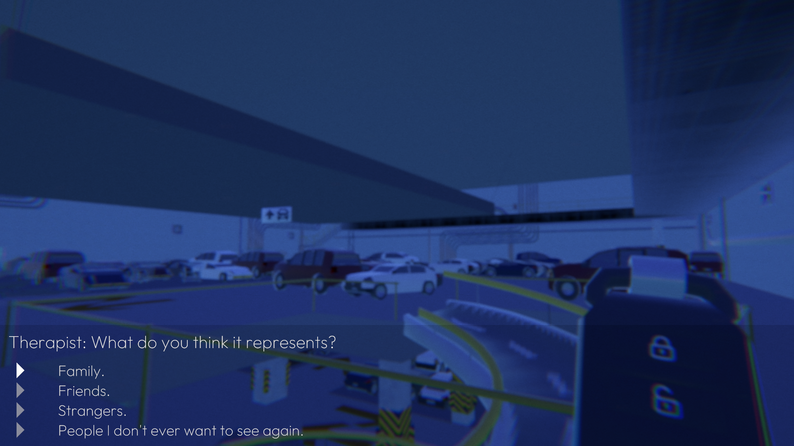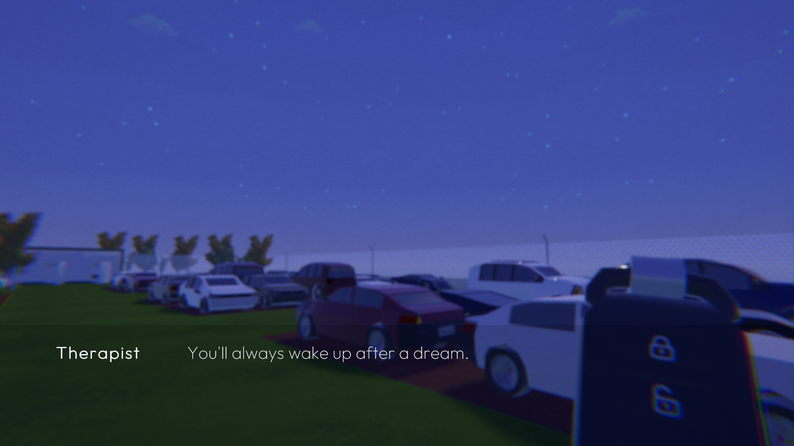
Step into a looping, surreal half‑wake: A Dream About Parking Lots takes a single, oddly specific compulsion; finding your car; and stretches it into a compact, meditative parable about feeling lost, creative block, and the uncanny architecture of the unconscious. In 30-40 minutes the game pairs retro‑styled, maze‑like parking lots with an intimate therapy dialogue, turning each keyed beep and stalled vehicle into a moment of emotional excavation; tactile exploration and quiet conversation combine so the act of searching becomes both a mechanical puzzle and a gentle self‑interview grounded in real dreams.
What the game is
• Premise: Walk a string of surreal parking‑lot mazes while you converse with your therapist about why these spaces haunt your dreams; the simple act of pressing your car key and following its beep becomes the game’s primary mechanic and a doorway between dream stages.
• Length and form: A compact, single‑sitting experience (about 30-40 minutes) that favors focused mood and narrative payoff over sprawling mechanics or puzzles.
• Tone and origins: Existential, gently unsettling, and often poetic; the script is drawn from real dreams and leans into ambiguity, prioritizing emotional resonance and interpretation rather than tidy explanation.

Gameplay and structure
• Exploration as metaphor: The loop is intentionally spare and ritualistic; walk the lots, press your key, listen for the beep, and follow that sound into the next fragment of the dream. The simplicity turns each mechanical action into a reflective beat, so navigation becomes less about solving a puzzle and more about tracing emotional breadcrumbs through shifting, symbolic spaces.
• Choice and voice: Dialogue choices function as tonal levers rather than branching plot forks; they shape the tenor of the therapy sessions, invite projection, and open small windows of catharsis. Responses alter how the conversation unfolds and how you read the dream, rewarding introspection and interpretive play instead of binary right-or-wrong outcomes.
• Pacing and crescendo: The design favors slow, deliberate stages that let atmosphere accumulate; moments of silence and the recurrent beep give space for thought. As the game progresses the dreams deepen and quiet questions surface, culminating in sequences that trade spectacle for resonance and leave you lingering on why we try to impose meaning on the unconscious.

Themes and narrative craft
• On being lost: Parking lots operate as a repeating emblem of uncertainty, stalled momentum, and creative paralysis. The act of searching; key in hand, guided by a distant beep; transposes an everyday annoyance into a patient, examinable ritual that teases out anxieties about direction, purpose, and stalled projects.
• Therapy as gameplay: The therapist exchanges form the game’s emotional scaffolding; questions, reflections, and gentle provocations dovetail with exploration so that conversation and action feel co‑dependent. Rather than delivering solutions, the dialogue reframes motives, surfaces contradictions, and lets the player experience therapy as an interactive, iterative process.
• Metafictional resonance: In later stages the game intentionally blurs authorship and perspective, slipping between player, dreamer, and developer voice. Those self‑reflexive beats unsettle expectations and invite interpretation, turning unresolved questions into the point of the piece rather than something to be neatly answered.

Presentation and feel
• Retro aesthetics intensified: The game’s pared‑down, stylized visuals lean into a nostalgic palette and intentional softness; coupled with selective depth‑of‑field, these choices produce a slightly hazy, half‑remembered quality that feels like moving through someone else’s dream rather than a faithfully rendered world.
• Sound and silence as scaffolding: The audio design uses sparse cues and ambient hush to make small sounds weighty; the car key’s beep becomes a heartbeat, footfalls echo like thoughts, and silence punctuates revelation. The soundscape privileges introspection and emotional cueing over bombast, so auditory moments guide mood and meaning.
• Quiet emotional resonance: Where the game excels is in its ability to land small, personal truths. The combination of minimalist visuals, intimate dialogue, and restrained audio routinely produces unexpected moments of recognition and clarity, leaving players with takeaways that feel less like answers and more like discoveries about themselves.

Technical rough edges
• Input and UI reliability: Several players report inconsistent mouse responsiveness (very low sensitivity or frozen input until alt‑tab), and an ESC/menu system that becomes unclickable after repeated opens. These interrupt the flow and can force restarts; a targeted input‑handling audit and a robust focus/GUI state reset will stop most of the friction.
• Visual artifacts that break mood: Harsh depth‑of‑field, occasional texture warping, and models that disappear from certain angles pull the game out of its dream logic. Toning the DOF intensity and fixing backface culling and texture UVs will preserve the intended haze without making the scene feel technically broken.
• Small stutters from system overlays: Brief hitches when OS-level overlays appear (notifications, volume HUD, Steam popups) undermine the game’s slow, meditative pacing. Buffering or gracefully suspending nonessential rendering when overlays appear, or reserving a single-threaded input path, will reduce noticeable frame spikes.
• Polish suggestions: A sensitivity slider with a wider range, fix for ESC menu reliability, and a softer depth‑of‑field option would immediately improve accessibility and comfort.

Who it’s for
• Play it if you enjoy short, introspective narrative games that privilege mood and metaphor over mechanical complexity and want a compact, thought‑provoking experience.
• Skip or wait if you prefer polished mechanical puzzles, faster pacing, or expect precise, photoreal visuals and rock‑solid input handling.
Final Verdict
A Dream About Parking Lots is a compact, affecting piece of game‑art: modest in scope but unusually generous in what it invites you to feel and wonder about. By stripping mechanics down to a ritual of searching; press the key, follow the beep; the game clears space for its therapeutic dialogue and the symbolic logic of its dreamscapes, so playing becomes a quiet act of self‑interrogation rather than a puzzle hunt. Small technical issues and some visual choices that occasionally pull against immersion keep it from pristine delivery, but those flaws are outweighed by sharp writing, unexpected emotional honesty, and a deeply uncanny use of a familiar, oddly intimate setting. If experimental narratives that linger are your thing, this short, well‑wrought trip through the architecture of being lost is worth a sit‑down; and likely to leave you thinking about what you were trying to find long after the credits roll.
Watch and Wishlist
• Why wishlist: Track post‑launch patches that fix input/UI quirks and tone down depth‑of‑field for clearer visuals.
• Catch content updates or extended modes that expand the dreamscapes and dialogue (more scenes, alternate therapy threads).
• Be notified of sales or bundle offers if you want the Complete Edition or any future DLC at a better price.
• When to jump in: Play now if you want a single‑sitting, artful experience and are comfortable with a handful of technical issues.
• Wait for the first post‑launch patch or a sale if you prefer a smoother, more polished run and full DLC value.
• How to keep up: Wishlist on your storefront and enable notifications for developer updates.
• Follow Interactive Dreams’ channels for patch notes, dev commentary, and any extra content or extended cuts.
• If you play early, report input/UI issues with clear repro steps to help prioritize fixes.
Key Takeaways
• A compact, resonant short: A Dream About Parking Lots delivers a focused 30-40 minute experience that rewards a single sitting with a clear emotional throughline.
• Simple mechanics, deep metaphor: The core loop (press the key, follow the beep) is intentionally minimal so exploration functions as ritual and the parking‑lot mazes act as an extended metaphor for being lost and blocked creatively.
• Therapy drives the narrative: Intimate therapist conversations are the game’s emotional engine; dialogue choices steer tone and invite personal reflection rather than branching outcomes.
• Strong writing and atmosphere: Poetic, semi‑autobiographical scripting, retro visuals, and a restrained soundscape create an uncanny, dreamlike mood that lingers after play.
• Metafictional payoff: Later moments fold perspective back on the player and developer, turning unresolved questions into the point of the piece and encouraging interpretation.
• Technical rough edges: Input/UI quirks (mouse sensitivity, ESC menu), depth‑of‑field extremes, and occasional visual artifacts interrupt immersion and should be addressed in early patches.
• Who will love it: Players who favor experimental narrative games, reflective pacing, and emotionally honest writing will find this a meaningful, memorable short.
• When to play or wishlist: Jump in now if you value the writing more than mechanical polish; wishlist or wait for a patch if you want fixes to input, UI, and visual clarity before committing.
Game Information:
Developer & Publisher: Interactive Dreams
Platforms: Xbox Series X (reviewed), Nintendo Switch, PC - Steam, PC - Itch.io, PlayStation 5
Release Date: March 14, 2025
Score: 9.0 / 10
A Dream About Parking Lots is a standout piece of interactive art: concise, beautifully written, and emotionally precise. It’s an essential play for anyone interested in how games can explore interiority and creative block, provided you’re comfortable with a short, deliberately spare experience and minor technical rough spots.